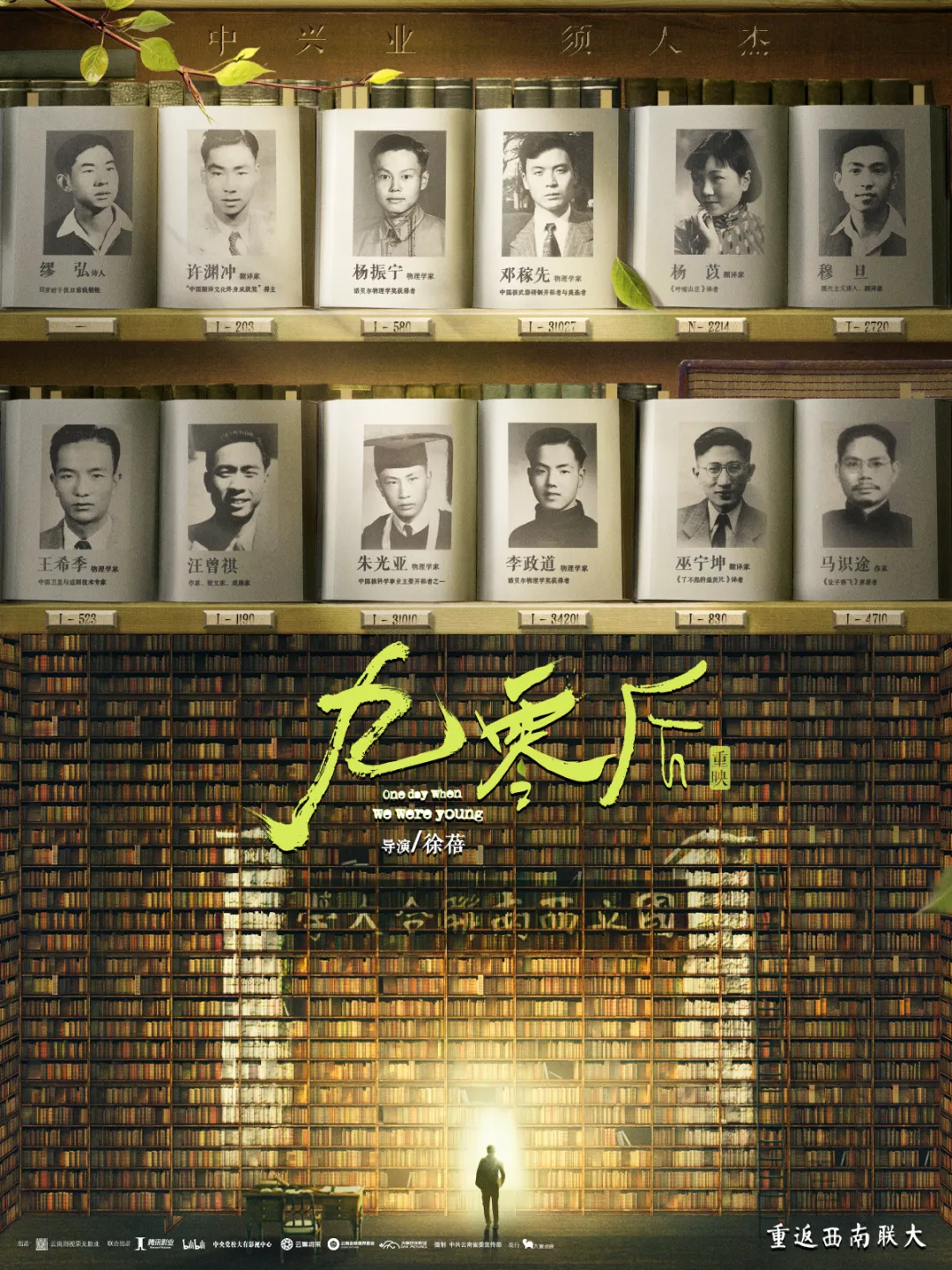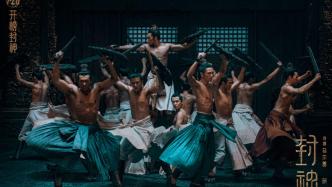
On July 20, the first part of the "Fengshen Trilogy", which took nine years to create, was released in China. Surrounding this "We Chinese Mythical Epic Blockbuster", there are too many topics worthy of being recorded. The "sound" wins people first, whether it is the golden and iron horse that leveled Jizhou at the beginning, or the proton war dance in the Longde Hall, and the Low C bass singing of "the mysterious bird of destiny, descending to give birth to business" in the magnificent enthronement ceremony all left a deep impression on people.
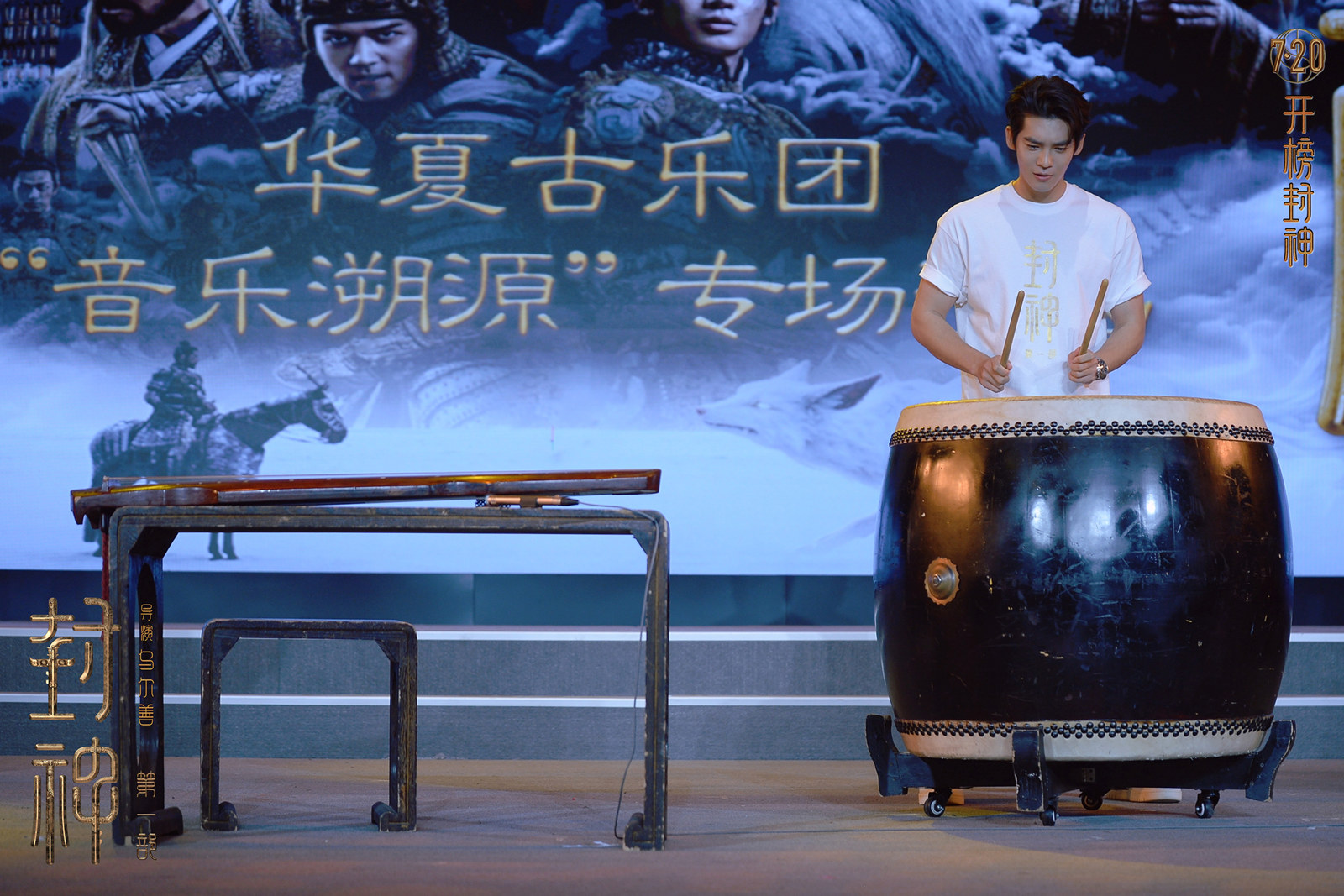
"Fengshen Part I" starring Yu Shi (played as Ji Fa) shows the results of drum music training
On July 19, Meng Ke Zhuolan, the music director and composer of "Fengshen Trilogy", posted an article on Zhihu, telling the story behind the soundtrack of "Fengshen Part One". ""The Trilogy of Conferred Gods" is a Chinese mythological and epic film, and the form of music should also have a way to match it. It should not only have a magnificent and magnificent epic sense, but also have a deep and delicate emotional expression. At the same time, it must also create a musical atmosphere in the Yin and Shang Dynasties."
At the end of the article, she wrote: "The creation of the music of "Feng Shen No. 1" is a complex process, including the use of Western symphony orchestras and the exploration of ancient Chinese musical instruments. This is also a pleasant process, allowing us to get in touch with the world three thousand years ago, to touch it, feel it, and imagine it!" Recently, Meng Ke Zhuolan accepted a telephone interview with The Paper.
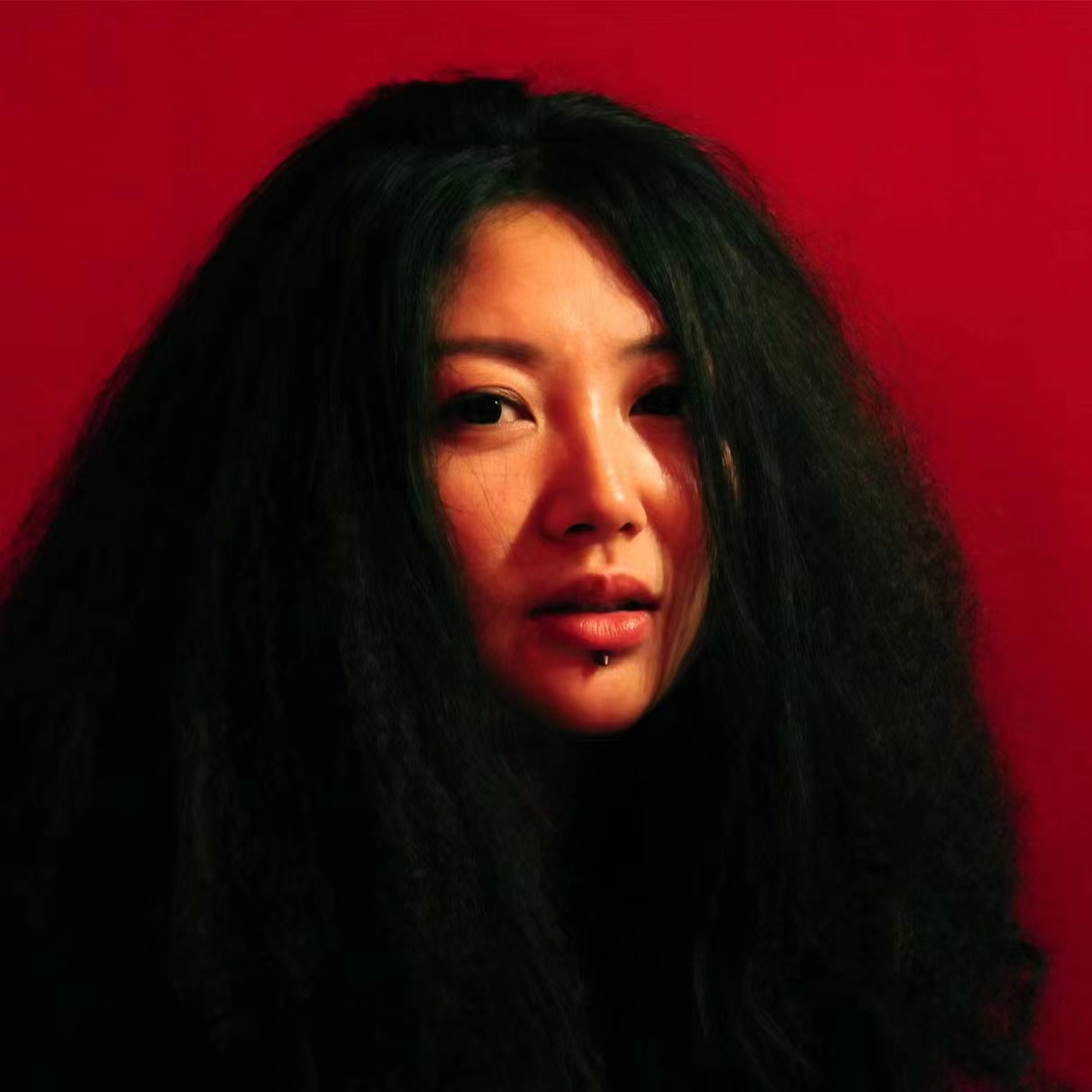
Mont Cotraran
【dialogue】
"Epic sense is the background color of this film's soundtrack"
The Paper: Can you introduce director Wu Ershan's vision and requirements for the film music of "Fengshen Part I" this time?
Meng Kezhuolan: In the initial music setting, the requirements given by the director were very clear. At the same time, the solid script also greatly helped the music creation. "Fengshen" is a mythical and epic movie. The epic sense is the background color of the soundtrack of this movie and the basis for the existence of the whole movie throughout. In addition, the oriental colors, Chinese elements, and the structure of the dialogue atmosphere with the world through the film all appear on the basis of the epic film. Therefore, the basic characteristic of our music creation this time is to use the symphony to reflect the charm of the epic.
I was particularly moved by the creation of the soundtrack for more than a year. Due to the epidemic, we had no choice but to use cloud recording, and the recordings were completed in the air studio in London and the recording studio in Vienna. Looking back, as musicians in Beijing, Los Angeles, London and Vienna, we were working together in different time zones to do the same thing. Through the video connection screen, you can see the changes of the sun and the moon every day outside the windows of their respective locations, and I really have infinite emotions in my heart.
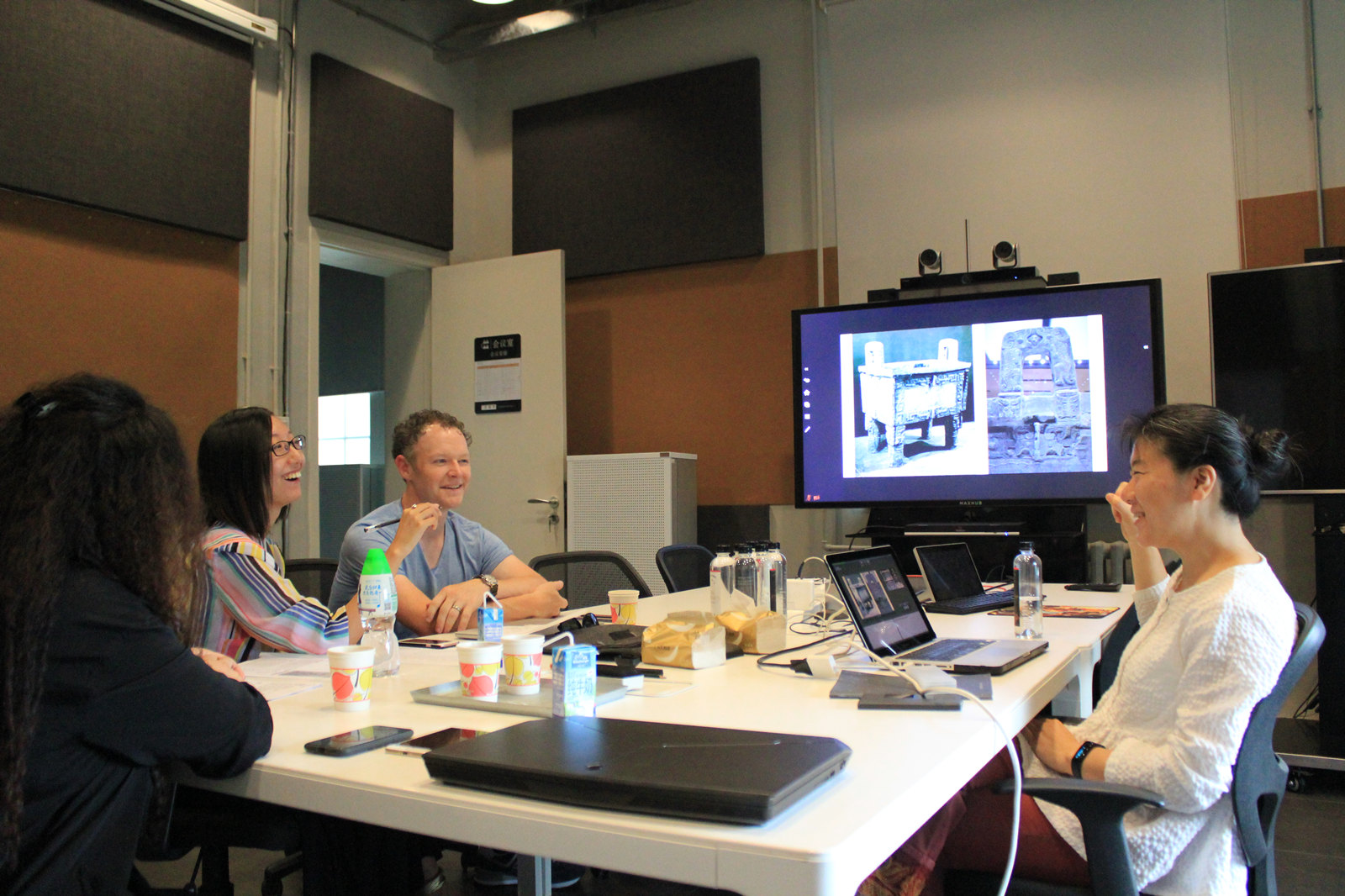
Meng Kezhuolan (left) had a meeting with the music creation team
The Paper: I noticed that this music creation is divided into two parts: the music in the narrative and the soundtrack. In the soundtrack part, the benchmark is Wagner's symphony writing style, please introduce it in detail.
Monte Cozoran: There are two ways that we borrowed from Wagner's music in the film. The first is the auditory experience presented by the Wagner Symphony Orchestra, which is basically magnificent and majestic, which is its very obvious characteristic. Moreover, many of his works are also mythological themes, such as "The Ring of the Nibelungen". The configuration and method of his writing symphony are very suitable as a basis for the epic sense of "Feng Shen".
The other is to borrow Wagner's writing method of "leading motivation" when he created operas-the main characters in the work have their own theme music, which changes with the development of the plot. When we were studying the script, we discussed with the director, what exactly does this movie want the audience to feel? Then it is determined that the hero theme and emotional theme are the core of the whole movie. On the basis of these two themes, a matching character theme was developed for the main character. In "The First Part of Conferred Gods", it is the young Ji Fa's yearning and growth for heroes. In addition, it connects the emotions between Ji Fa and his hometown Xiqi, the father-son relationship between the same biological father Ji Chang, and the presentation of other father-son relationships in the film.
The Paper: From my personal experience, these two theme musics are not only accompanied by Ji Fa's experience in the film, but also have corresponding variations been made for the main characters such as Yin Shou?
Meng Kezhuolan: The character Ji Fa bears the carrier of yearning for and becoming a hero. In many places in the film, when Ji Fa appears, the music will present his heroic theme. For other characters, such as Yin Shou, in Ji Fa's eyes, Yin Shou was a hero in the opening battle of Jizhou City, so when Yin Shou led the Proton Brigade to charge, the heroic theme was also used, and it was fully presented. But later, Yin Shou was gradually discovered by everyone that his inner desire for power was expanding, which undoubtedly ran counter to the image of a hero. We would make variations on the music theme of this character—the music of the hero theme generally has a very uplifting melody, giving people a leading, passionate and upward feeling. But when Yin Shou showed his evil side, we reversed the hero theme, and the audience would feel that the melody of the music was sinking, showing Yin Shou's depravity and darkness, but this part of the music was still a variation on the hero theme.
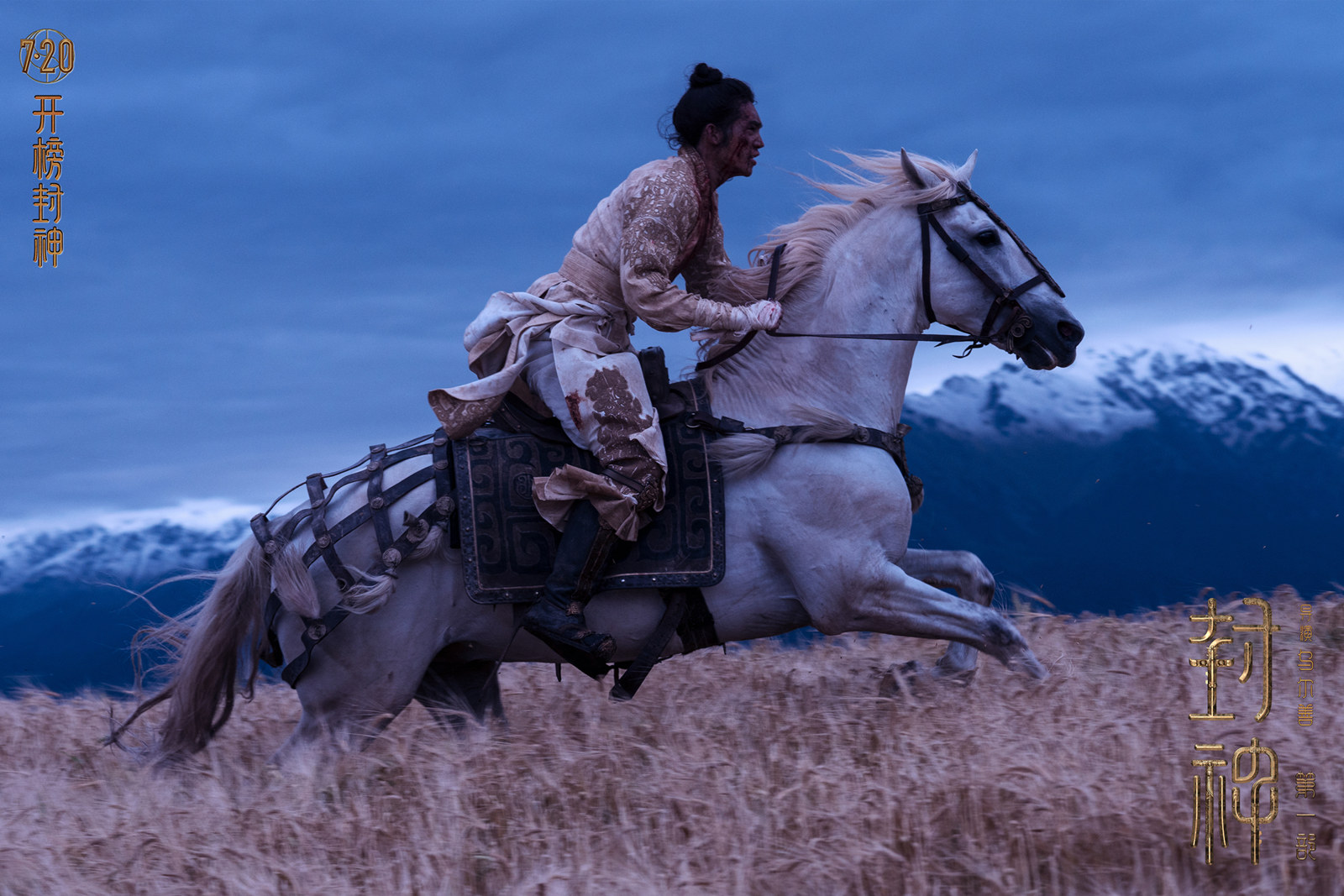
Stills of "Fengshen Part I"
The Paper: After Jifa "assassinates" Yin Shou at the end of the film, he rides a white horse to avoid the pursuit all the way until he returns to Xiqi. I feel that the heroic theme and the emotional theme are used intertwined.
Meng Ke Zhuolan: Yes, Ji Fa made the right choice at the end of the film. He has a series of heroic dramatic actions, assassinating Yin Shou, flying on a horse, looking back and shooting an arrow... At this time, he is completely in a winning posture, and the image of a hero is completely established. The echo is naturally a full presentation of the heroic theme. When he went all the way to the city gate of Chaoge, the old Paoze brothers resolutely opened the door to let him go in order to fulfill him. At this time, a variation of the previous emotional theme music was used.
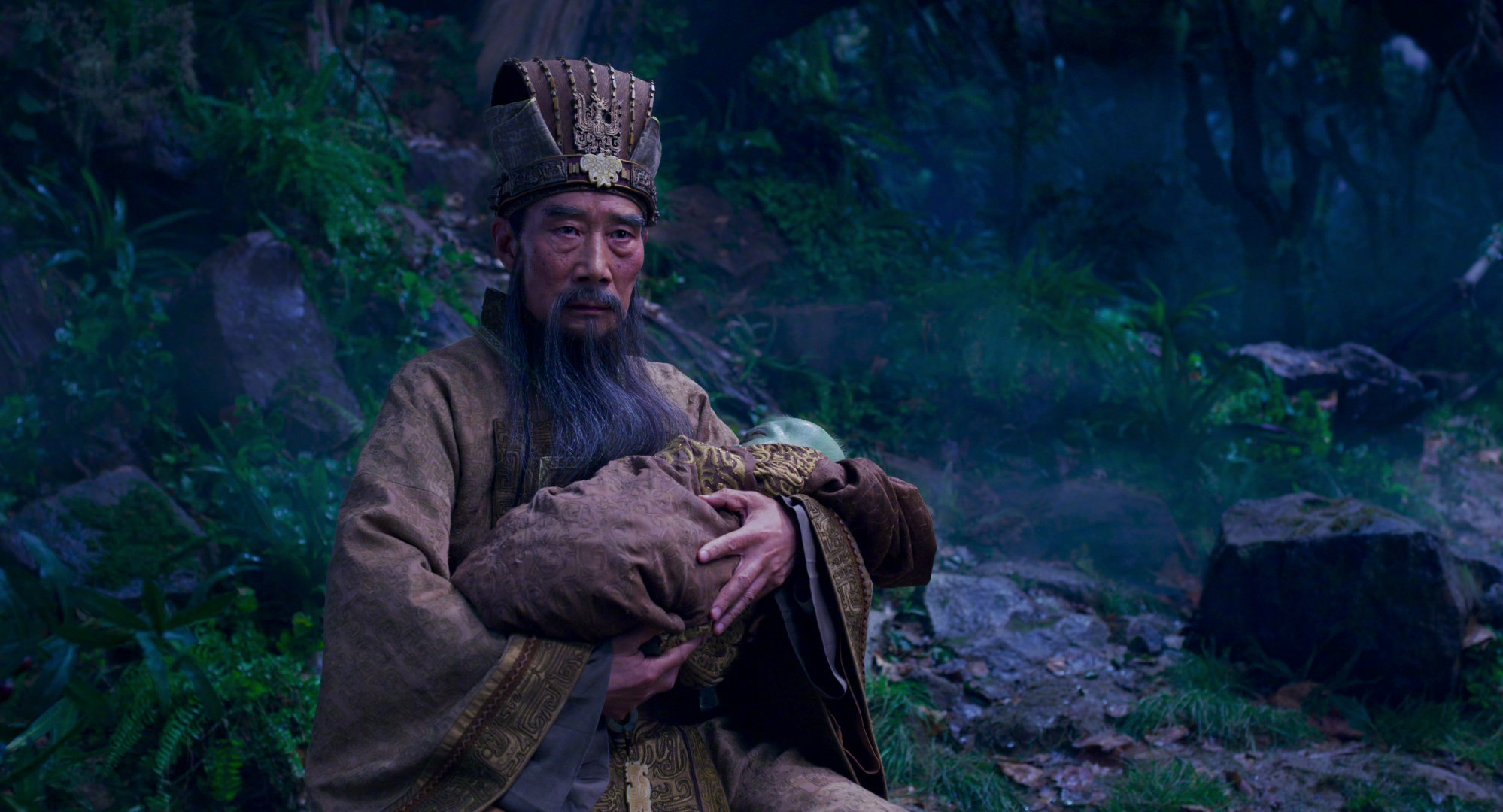
Stills of "Fengshen Part I"
From Lei Zhenzi holding Jichang, until Ji Fa returned home and returned to his father's bedside, the entire large piece of music is a complete presentation of emotional themes. Lei Zhenzi holding Ji Chang and flying to Xiqi is the beginning of the emotional theme music. From Ji Chang's line "Children, let's go home!", the emotional theme of the music slowly appears, and it extends to the end of the film in line with the changes in the screen. In the plot, Lei Zhenzi flew back to Xiqi with Ji Chang in his arms, followed by the scene where Ji Fa was carried by Xuelongju and flew towards Xiqi. During the process of Ji Fa returning home, there were no lines presented, except for flashbacks to the dialogue between his brother Bo Yikao and him. The music has been a constant emotional theme development throughout this period, serving as a foil to what is said.
"The Heroic Theme Should Be Impressive"
The Paper: This time it is the American composer Gordy Haab who will complete the soundtrack. Please introduce the process of cooperation.
Mont Kejuran: Gordy Harbaugh's symphony writing style has a particularly majestic temperament. He has written the soundtracks of the "Star Wars" series of movies and games, and was also known as "John Williams' successor". He has very rich experience. His shortcoming is that he doesn't know anything about oriental and Chinese music. So soon after the filming started, we invited him to China. After meeting with the director and visiting the set, we took him to visit museums in Henan and Hubei. During the period, a teacher of Chinese musical instruments was also arranged to give him lessons to learn about guqin, sheng, zither and other instruments. He also found a lot of ancient Chinese music to listen to, so that he could have a certain perceptual knowledge and accumulation of ancient Chinese melodies.

Gordy Harbaugh tries to play the guzheng
After we officially determined that the theme of the soundtrack was hero theme and emotional theme, he had already returned to the United States at that time, and soon wrote out the music of the emotional theme. The first shot of the director’s shooting was Ji Fa back to Xiqi. Afterwards, only two or three drafts were changed, and the emotional theme music was finalized. I admire him very much for this.
The Paper: It is said that more than 50 drafts were written on the hero theme before it was finalized?
Meng Kezhuolan: I found him a lot of information on ancient music, let him feel what the mode of the East is like, and what is the relationship between the intervals and the intervals in the music written in the East. He needs a process of repeated internalization. Writing the hero theme is indeed very difficult. We have written more than 50 drafts in total.
In fact, the difficulty of writing the hero theme this time is not limited to the differences in the understanding of Eastern and Western music. If it is just to highlight the differences, he can grasp it accurately immediately. After all, the director's request is that the hero-themed music must be concise, memorable, and rooted in people's hearts at once. Such a requirement is undoubtedly to produce classics, and the creation of classics, frankly speaking, is rare and cannot be sought, and can only be tried repeatedly.
It took Gaudí three months to create these two themes. There was no gorgeous band configuration, and only simple piano sounds were used to create them. If the melody presented by the piano can be unforgettable, it is enough to show that the theme music can touch people's hearts. Sometimes, he will only use French horns without other orchestration (to create). I basically listened to 50 drafts of the piano before deciding on the current hero theme. During this process, Gaudi’s professionalism and cooperation, as well as his patience, can be said to reflect the top level in the industry.

Gordy Harbaugh on drums
The Paper: Based on your observations during this cooperation, which Chinese musical instrument is Gaudí most interested in?
Meng Kezhuolan: When we went to Henan for inspection, a friend from the Henan Museum gave Gaudí a Xun at the time of parting. He was very happy because he had never seen such an instrument before. Among Western musical instruments, there is no pottery instrument like the Xun that can play such a sound. It seems that it can bring the soul of a person to ancient China at once. There is a kind of sadness in the mystery, which makes Gaudí particularly fascinated. Including when he was taking a Chinese musical instrument class, he was also very interested in the zither. At that time, the teacher of the Central Conservatory of Music showed the modern zither developed by himself.
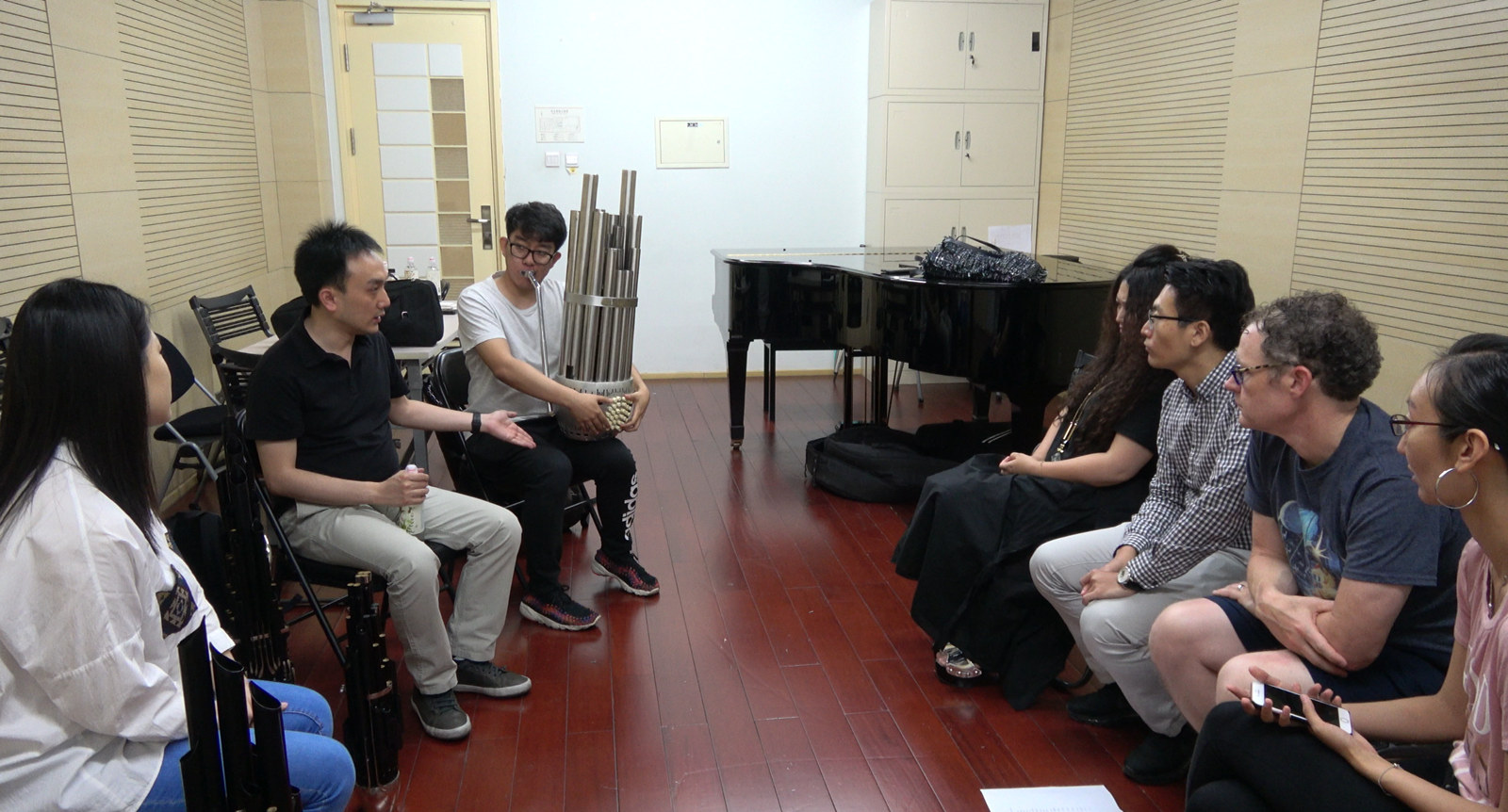
Music producers such as Meng Kezhuolan, Gaudi Harbaugh, Yu Fei are taking traditional Chinese musical instrument lessons
The Paper: After hearing that the director liked the works of the Polish composer Penderecki, Gaudí chose to use Penderecki's writing style to compose the soundtrack of "The Confrontation between the Father and Son of the Four Lords of the Longde Palace". We all know that Penderecki's most famous work is "Elegy for the Victims of Hiroshima". His music often contains a kind of religious compassion, and often creates a sense of tension between phrases.
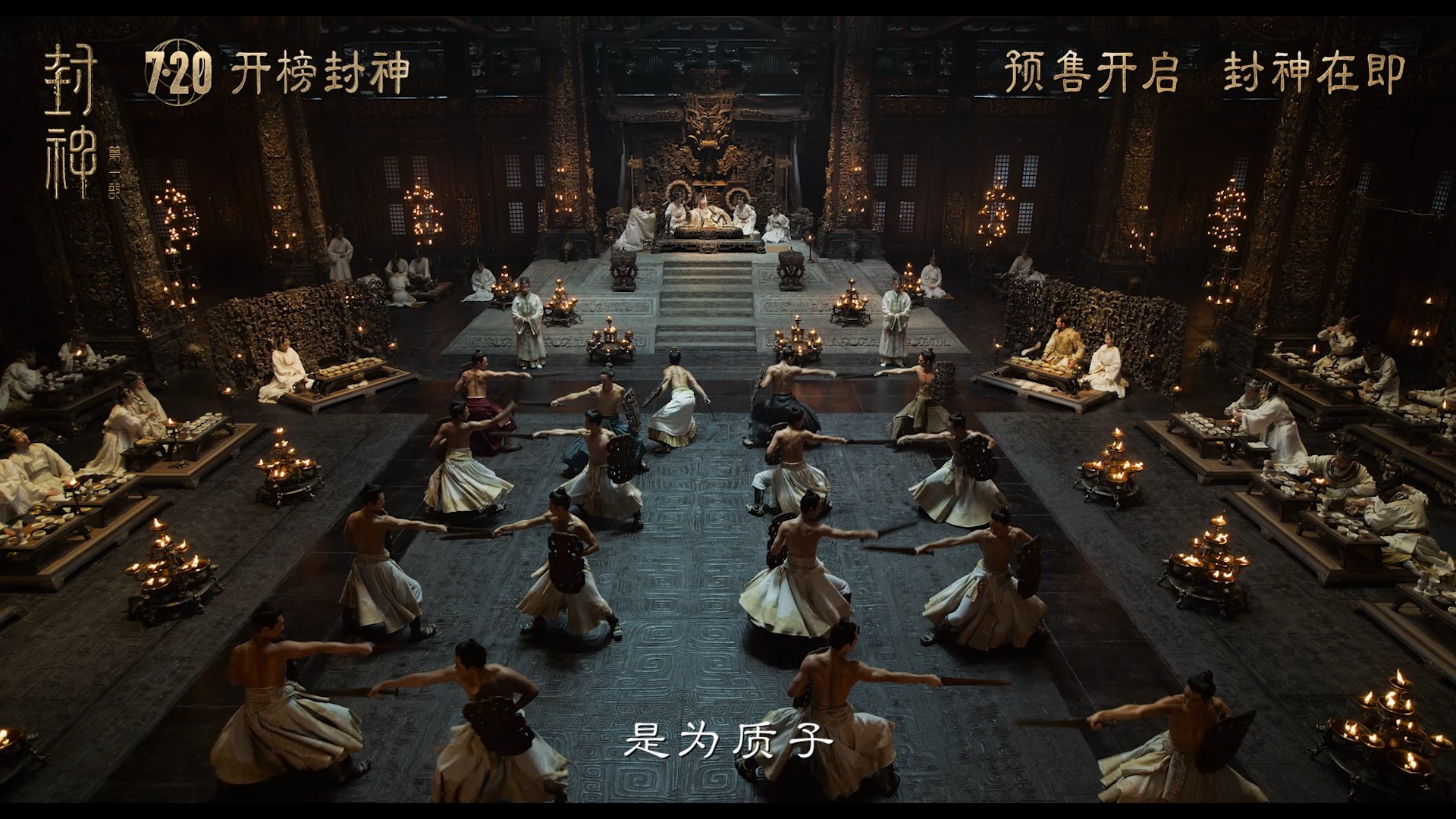
Stills of "Fengshen Part I"
Monte Kejuran: The director gives people a more classical feeling, but he personally prefers music with a strong impact. Penderecki belongs to modern and contemporary composers. His composition method often does not use harmonious harmony writing to promote music, but emphasizes the change and interweaving of timbres between instruments to structure movements. His works sound messy at first glance, but they are especially suitable for showing the inner struggle of the characters. "The scene of the confrontation between the father and son of the four uncles in Longde Palace" is undoubtedly a human tragedy. Yin Shou's suppression and inducement, the fear and tearing of the protons, and the anger of the uncles, all kinds of extreme emotions are mixed together, and the tension of the drama itself will make people hold their breath. Using Penderecki's writing style to show the tension of this episode, Gaudí's choice is very precise.
"They sang all the low C's in their life"
The Paper: The music in the narrative needs to create the music atmosphere of the Yin and Shang period, and also present the music performance form of the Yin and Shang period. How did you start creating this aspect?
Meng Ke Zhuolan: We have found Mr. Xiang Yang, an expert on the history of ancient Chinese music. He gave us a one-month music archeology class from the perspectives of the ritual system of the Shang Dynasty, the configuration of the band, and the classification of ritual music. In fact, the most difficult thing about making music in the narrative of the movie this time is the choice of musical instruments - the Shang Dynasty was a dynasty three thousand years ago, and currently only bronze bells and pottery xuns are left, because these will not rot. Because the stringed instruments have been separated for too long, it has been impossible to find the real objects of that year.
Based on the "Classification of Eight Musical Instruments" in "Zhou Li·Chunguan·Master", we have identified musical instruments such as the cymbal, chime, building, chi, yu, xun, and jiangu. These musical instruments are recorded in the "Li of Zhou", not that they only appeared in the Zhou Dynasty, but that they were summarized and classified in the Zhou Dynasty. The specific age of appearance and occasion of use can be traced back. Mr. Xiang Yang led us to think that ancient musical instruments should not be limited to a specific point in time. Its shape has evolved and developed, so it can be deduced forward and backward, which gave me a lot of inspiration.
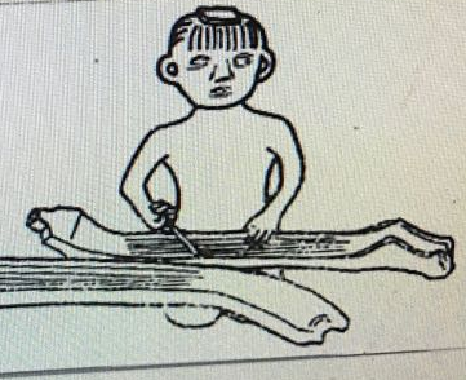
Archaeological reference rubbings of the musical instrument "Zhu" in the movie "Fengshen Part I"
For example, this time we tried to restore the ancient plucked stringed instrument "Zhu". It is similar in size to a guqin, but with bridges and wooden picks for plucking. In the past, we all know the allusion of "Gao Jianli is good at building". Based on the current archaeological materials, we can find clear pictures of the slender buildings of the Han Dynasty, but the Han Dynasty and the Yin and Shang Dynasties were almost a thousand years apart. We searched further and found a hollowed-out architectural metal sculpture of the Spring and Autumn Period, Jiyue Copper House, in which several bare-chested figurines of musicians were playing. According to the test, the musical instrument used by a musical instrument is Zhu. We restored this musical instrument in the movie through the rubbings of this musical instrument (instrument).
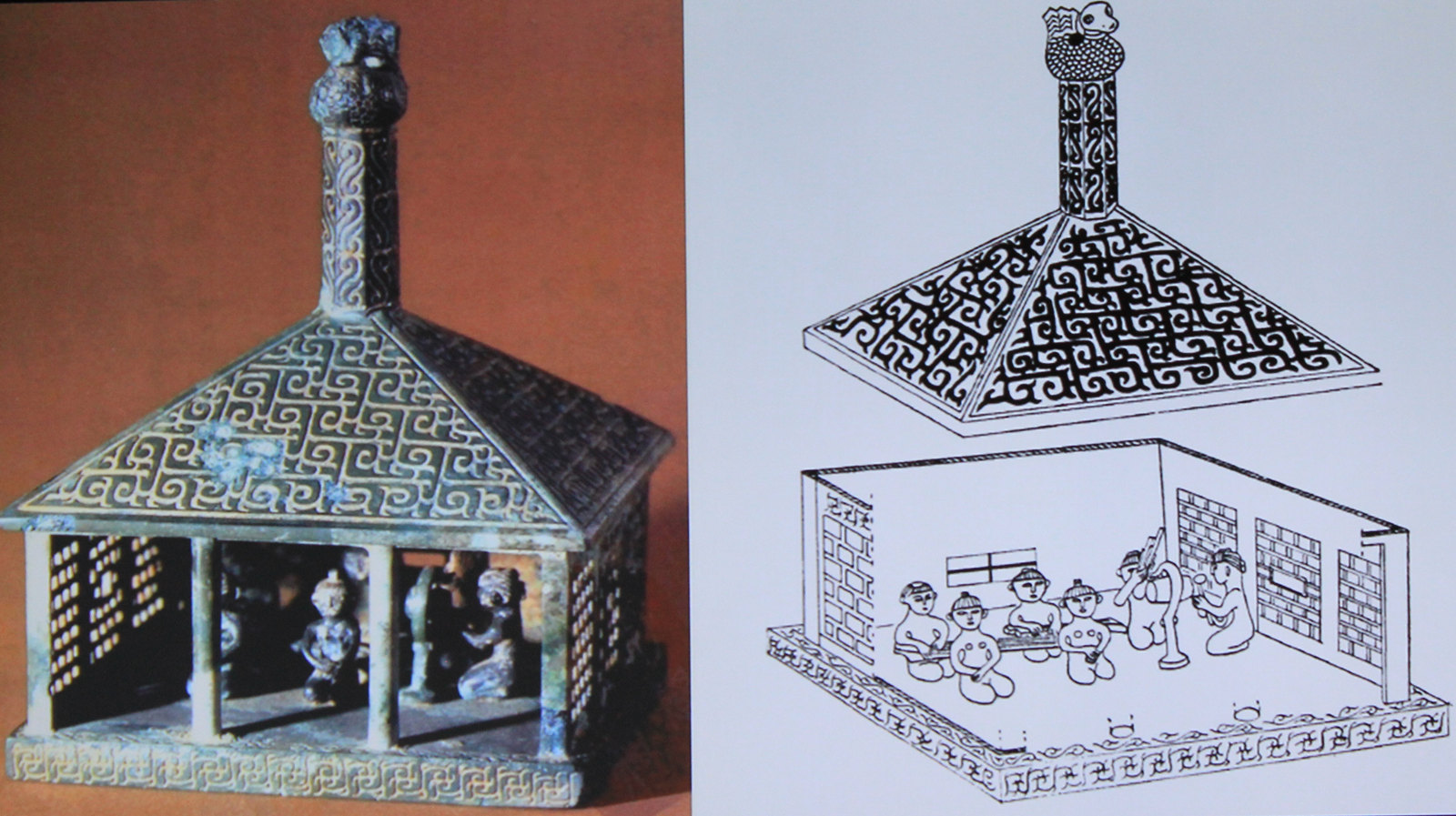
Jiyue Copper House and Rubbings
The Paper: I personally have a question. There is a "treasure of the town hall" in Henan Provincial Museum, a chime bell unearthed from the sacrificial site of Zheng State. In the past, when we described ancient music, we also used the term "Huang Zhong Da Lu". Why is there no chime in the music in this narrative?
Meng Kezhuolan: As you said, it is the "Zheng Guo" chime bell, which is a percussion instrument in the Zhou Dynasty. In the Shang Dynasty, the cymbal is more common. The most notable difference in appearance between bells and cymbals is that, in layman's terms, the big mouth of the bell is pointed downwards, while the big mouth of the cymbals is pointed upwards. The cymbals are not hung on the frame like a chime bell, but are placed on the frame with the protrusions at the lower end. This also reflects the development of smelting technology in different periods. In order to be close to history, we used weaving cymbals this time.

Bronze cymbals unearthed from the tomb of Fu Hao in Anyang City, Henan Province. Picture from: Henan Museum
The Paper: Is "Fengshen" the first collaboration between you and the director? Please also introduce your experience and preferences as a musician besides composing for films?
Meng Kezhuolan: Actually, we have collaborated since the director's "Journey to the Sword". The music of that film is divided into three parts. I, Shao Yunpeng and Gong Geer each received a part of the film's soundtrack. In "Painted Skin II", the director invited Japanese composer Katsuno Ishida, and I just wrote the pipa piece by Yui in the film.
I was majoring in composition at the Central Conservatory of Music and the Ecole Normale Supérieure de Paris. As far as my personal works are concerned, I prefer the style of experimental music. At the same time, I started to study Chinese traditional music and folk music very early, and I prefer to use traditional Chinese musical instruments to compose, such as drums, guqin, pipa and other instruments. In 2010, teacher Zhu Zheqin's "The World Sees" tour and the album "Moonrise" were created by me using the folk song materials she collected from five ethnic regions across the country.
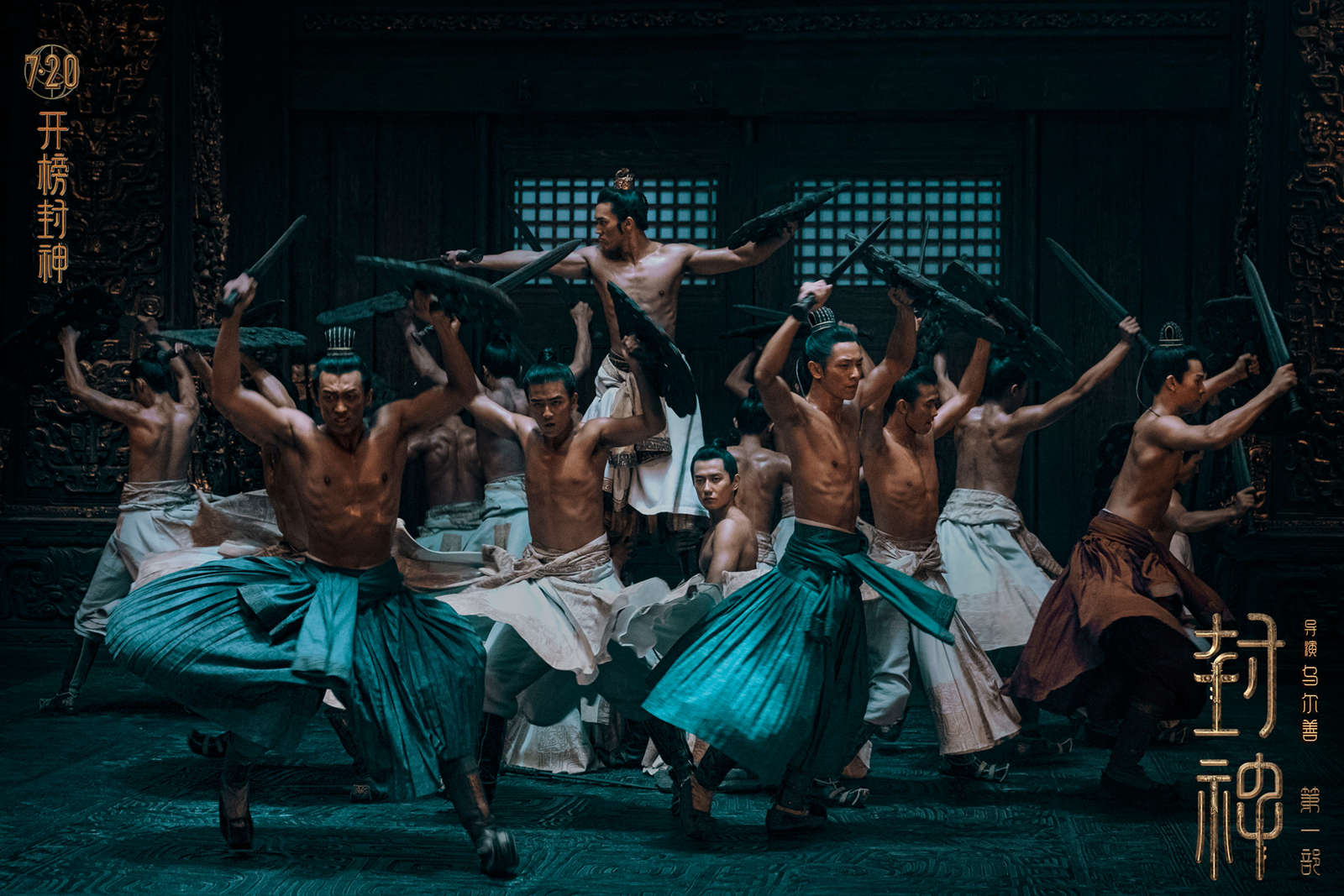
Stills of "Fengshen Part I"
The Paper: When it comes to folk music, I know you are also a Mongolian musician. Are there any elements of Mongolian music in the music of "Fengshen" this time?
Meng Ke Zhuolan: The scene of the film sacrifice ceremony, because this is a large-scale religious event, we included some shaman-style music elements in the creation of the sacrifice music. Shaman culture is a part of the Mongolian religious belief, and usually drums, human voices and other sound elements are used in rituals. Rather than saying that we have extracted elements of Mongolian music this time, it is better to say that we still seek inspiration from shaman culture.
Specifically, this kind of sacrificial ceremony needs to use the element of "song". We added mixed voices of men and women to sing the poem "Ode to Shang·Xuanniao". The high-frequency group singing of female voices is used to express the state of singing together with instruments with rising timbres such as sheng, yu, and bell. At the same time, as a contrast, the extremely low chanting of the male voice adds to the low-pitched solemnity of the sacrifice itself. I hope that the bass part of the male voice must be particularly solid, so as to highlight the sense of power and mystery. In the track of this male voice, I actually spread Hoomei, but I didn't want the voice of Hoomei to be too obvious. It is just the "background" of this part of the male voice, and it can't overwhelm the main character. At that time, I found eight basses from the opera house and asked them to record only the lowest note in the way of singing. After the recording, the leader told me that they had sung all the low C in their lives (laughs). It can be said that the chants of Humai and male bass are combined to form the current male voice.


